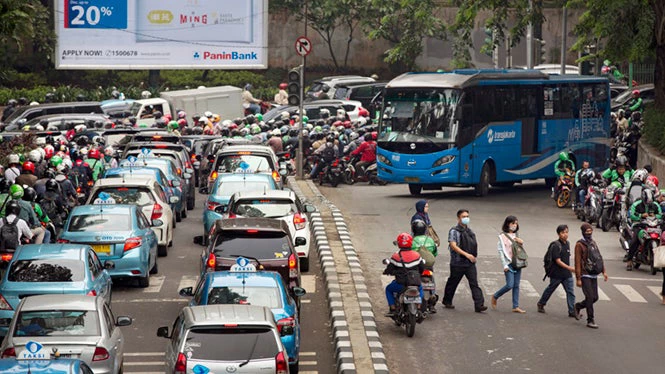
Central government spending on transport increased by threefold between 2010-2016. This has enabled the country to extend its transport network capacity and improve access to some of the most remote areas across the archipelago.
The country has a road network of about 538,000 km, of which about 47,000 km are national roads, and 1,000 km are expressways. Heavy congestion and low traffic speeds translate into excessively long journey times. In fact, traveling a mere 100 km can take 2.5 to 4 hours. The country relies heavily on waterborne transport and has about 1,500 ports, with most facilities approaching their capacity limits, especially in Eastern Indonesia. Connectivity between ports and land infrastructure is limited or non-existent. The rail network is limited (6,500 km across the islands of Java and Sumatra) and poorly maintained. The country’s 39 international and 191 domestic airports mainly provide passenger services, and many are also reaching their capacity limits.
Indonesia has 15 major cities with over 1 million inhabitants. Public transport in these cities is scarce and unreliable, with a low usage rate (5%-20% of trips). Hardly any consideration is given to non-motorized transport. Cities need to enhance their technical expertise to plan, design, implement, and operate public transport systems; increase the funds to develop mass transit systems; and strengthen institutional capacity to integrate transport and spatial planning more closely.
Indonesia has experienced a drastic rise in motorized transport over the last two decades, caused by subsidized fuel, rising incomes, and low interest rates for vehicle loans. In combination with the limited infrastructure, rapid motorization exacerbates the adverse environmental impact of transport: the sector currently accounts for 70%-80% of all outdoor air pollution in the country (including particulate matters), and 23% of greenhouse gas emissions.
Low transport infrastructure performance and capacity is one of the most critical barriers hindering Indonesia’s competitiveness and fueling social inequality across the archipelago. Indonesia ranked only 63rd in the 2016 Logistics Performance Index. The country’s global ranking has decreased ten positions since 2014, mainly due by the deterioration of its infrastructure—one of the worst within the Association of Southeast Asia Nations countries (ASEAN), and far behind its closest neighbors such as Malaysia or Singapore.
Sound transport strategies and policies will be crucial to boosting Indonesia’s economic growth and achieving the Sustainable Development Goals, specifically Goal 9 to ‘’build resilient infrastructure, promote sustainable industrialization and foster innovation’’ and Goal 11 to ‘’make cities inclusive, safe, resilient and sustainable.’’
There are several important priorities Indonesia must tackle in order to develop a more sustainable transport system:
- Expansion and modernization of the maritime, rail, and air networks to increase transport efficiency across the nation
- Creating efficient, affordable, and green public transport networks in the main urban areas, including by building more Bus Rapid Transit, light rail or heavy rail systems, and by investing in energy-efficient, low-emission public transport vehicles
- Developing infrastructure, policies, and communications to encourage the use of non-motorized transport, including safer corridors for pedestrians and cyclists
- Promoting the implementation of stricter vehicle emissions standards to improve vehicle energy efficiency
- Restricting private car use through the implementation of fees in heavily-congested areas
- Encouraging the use of electric vehicles through incentives, such as tax exemptions and the construction of a wide network of charging stations
- Enhancing private sector participation and limiting the role of State-Owned Enterprises to foster a more competitive environment.


Join the Conversation